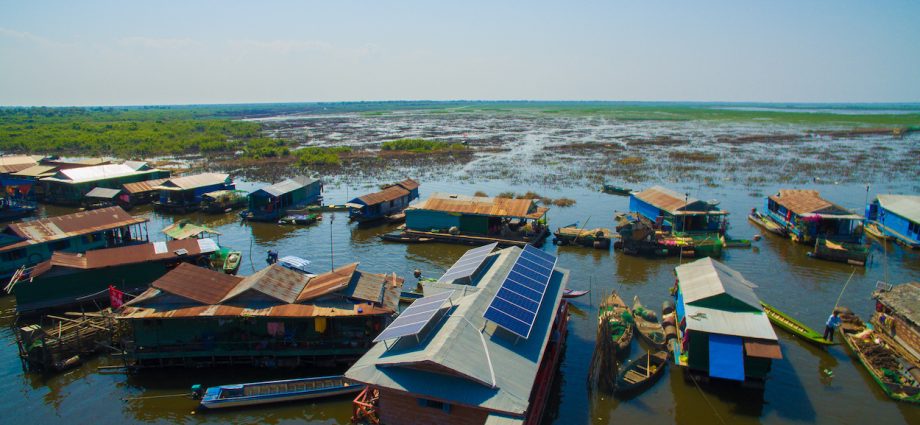Climate change, the Covid-19 pandemic, and geopolitical conflicts have caused enormous disruptions to energy and food markets, driving prices to record highs, impacting the poor most severely. In Cambodia, hard-earned development gains were lost, and the country’s Human Development Index regressed to its 2018 level.
The cascading energy, food and financial crises impacted economic, education, employment and health outcomes, particularly for the most vulnerable.
At the onset of the pandemic in 2020, the Cambodian government upscaled its social assistance. More than 700,000 poor and vulnerable households received cash assistance to offset the socioeconomic impacts of the pandemic.
In 2022, about 500,000 additional near-poor households were included to minimize their vulnerability to the impacts of floods and inflation.
Undoubtedly, these measures slowed the loss of development and the slide of vulnerable households into poverty. But immense pressure was exerted on public finances and the financial resources available for achieving the Sustainable Development Goals (SDGs) had to be repurposed.
Even before the pandemic, achieving the SDGs was highly dependent on sustained investment, the adoption of effective policies, and the ability to implement them on time. Although rapid economic recovery in Cambodia is attracting foreign direct investment, refueling the economic engines and creating jobs is still vulnerable to external shocks and uncertainties.
Interconnectedness
Although fuel and commodity prices have eased globally to varying degrees, concerns remain, as they are still above historical averages. Dependence on fossil fuels is causing a current-account deficit in the country.
In 2021, about US$57 million were spent on fuel subsidies in Cambodia. In January and February 2022 alone, the subsidy accounted for $31 million – resources that could have been invested in development.

A 2020 study indicated that Cambodia could save $250 million by 2040 in direct power-system costs if the national energy grid mix was 14% solar photovoltaic, notwithstanding other indirect environmental and socio-economic impacts (such as a 38% increase in job creation).
Such socio-economic gains cannot be underestimated. Also, the performance of the energy sector directly affects the country’s climate agenda. Cambodia increased its mitigation ambition with an emissions-reduction target of 41.7% by 2030. This included specific targets in areas such as energy efficiency.
Cambodia remains highly vulnerable to climate-change impacts. The increased frequency of extreme weather events is making harvests more unpredictable and reducing crop productivity, threatening food security and farmers’ livelihoods, notwithstanding other types of loss and damage.
In 2020, a 50% prevalence of food insecurity was reported in Cambodia. A study by the Ministry of Economy and Finance assessed that Cambodia’s expected GDP could decline by almost 10% by 2050 because of loss and damage due to climate change. Recovery requires public investments that will further reduce fiscal space.
The country is at a crossroads
New opportunities can emerge from the crisis. Innovation is vital to renew development momentum and improve resilience. This would require new technologies, business models, policy frameworks, and social advances that prioritize synergies across energy, food, and finance.
For instance, low-carbon farming offers the opportunity to optimize the use of fertilizers, raise agricultural yields, and reduce environmental impact. Clean energy improves the resilience of the agriculture sector and accelerates agri-food value chain improvement through secure irrigation, cold storage, and the use of agricultural residues for clean cooking – a health concern for rural women and girls.
Energy efficiency plays a key role by bringing gains in different sectors of the economy and reducing energy sector vulnerability and energy uncertainty. The National Energy Efficiency Policy identified that Cambodia has the potential to save 12.5 terawatt-hours of energy (1.07 million metric tons of oil equivalent) by 2030 through energy efficiency measures. The financial savings could be reallocated to support development priorities and the SDGs.
Recalibrating public financial management is vital through the integration of the SDGs in the budgeting process, exploring new approaches to revenue mobilization and reforming wasteful agricultural, food, and fossil-fuel subsidies. Cambodia has developed a methodology for monitoring and tracking SDGs-related expenditures in the national budget system, which is expected to be institutionalized soon.
Finally, as a Least Developed Country, Cambodia has been benefiting from concessional financing, but once it graduates from LDC status, its financial architecture will progressively evolve.
Unlocking private capital and scaling up private-sector investment is key to expanding SDG-related investments. It will require removing barriers to direct financing from private institutions such as high interest rates, short repayment periods, and stringent collateral requirements, as well as prioritizing SDGs’ impact investments.
This is where blended finance can also de-risk investments in the agri-food sector and clean energy, to boost business but also food and human security.
The road to resilience passes by the energy, food, and finance nexus. The risks posed by this nexus will become more significant because of growing demand for energy and food in a context of uncertainty and decreasing domestic and international financial resources for development.
A systemic approach to policymaking and investment that considers their interconnectedness, multi-sectoral nature and the need for multi-actor partnerships prioritizing synergies across energy, food, and finance is needed to break the vicious cycle of vulnerability.

